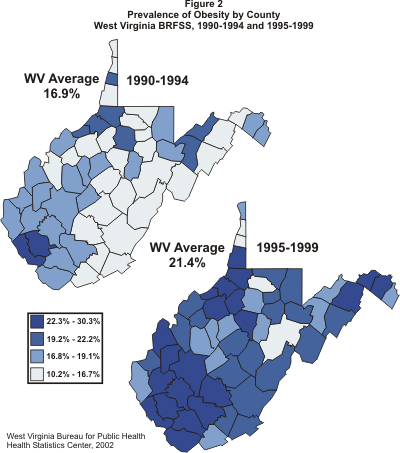
Contents
| WV | DHHR | BPH | OCHSHP | HSC |
Obesity:
Facts, Figures, Guidelines
Section Two
OBESITY IN WEST VIRGINIA
The prevalence of obesity as measured by the Behavioral Risk Factor Surveillance System (BRFSS)4 has increased both nationally and statewide over the past decade, at an average annual rate of 5.9% in the U.S. and 5.2% in West Virginia, with the state’s rate consistently higher than the national rate over the years. In 1990, the West Virginia rate was 15.0%, compared with the U.S. rate of 11.6%. By 2000, the West Virginia rate was 23.2%, compared with 20.1% for the nation as a whole.
Figure 2 depicts changes in obesity prevalence on the county level, comparing aggregated data from 1990-94 with that from 1995-995. As the maps show, obesity has increased in virtually allof West Virginia’s 55 counties, with the highest prevalences found in the southern and western portions of the state, as well as the Eastern Panhandle. (Individual county rates are found in Appendix 1.)Tracking the average weight in pounds for men and women from 1984 through 2000 has shown steady year-to-year increases for both sexes, with few exceptions over the 16-year period (Table 1). In 1984, the average weight of adult males in West Virginia was 177.2 pounds; by 2000, this had increased to 194.0 pounds. A similar increase was charted for the state’s women, from an average weight of 142.0 pounds in 1984 to 154.9 pounds in 2000.
Table 1 |
||
| Year | Men | Women |
|---|---|---|
| 1984 | 177.2 | 142.0 |
| 1985 | 176.6 | 143.4 |
| 1986 | 176.3 | 143.3 |
| 1987 | 178.6 | 142.3 |
| 1988 | 182.4 | 142.2 |
| 1989 | 179.1 | 144.7 |
| 1990 | 182.2 | 145.0 |
| 1991 | 184.2 | 146.8 |
| 1992 | 185.0 | 147.1 |
| 1993 | 184.1 | 150.3 |
| 1994 | 186.3 | 149.7 |
| 1995 | 185.8 | 150.8 |
| 1996 | 186.9 | 153.1 |
| 1997 | 188.8 | 152.6 |
| 1998 | 191.0 | 154.2 |
| 1999 | 193.3 | 157.2 |
| 2000 | 194.0 | 154.9 |
4The BRFSS is a monthly telephone survey established by the CDC that allows states to monitor health behaviors among their adult population (18+). The BRFSS was begun in 1984 with 15 participating states and has monitored obesity since that time, expanding to 52 states and territories in 1997. Return to Text
5In order to provide risk factor data on a substate level, county BRFSS data were combined into five-year agregates. For the prevalence data presented in this report, 24 counties had aggregated sample sizes large enough to yield individual prevalence calculations. Samples from the 31 counties that had sample sizes too small to stand alone were combined with samples from other less-populated, contiguous counties into 12 groupings, or multicounty regions. A single prevalence was then calculated for each grouping: this rate was then used as the prevalence for each county within that grouping. Return To Text
- Weight Category Prevalences
- Weight Category and Health Status
- Chronic Disease Prevalence
- Weight Category and Seatbelt Nonuse
- Prevalence and Weight Reduction
- Dietary Intake Study
- Obesity and other Cardiovascular Disease Risk Factors
- Overweight among West Virginia's Youth
- Physical Activity among West Virginia Youth
- Health Care Expenditures due to Obesity in West Virginia
- Top of Page

